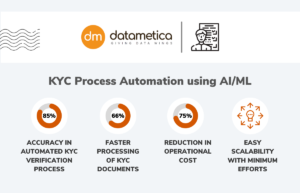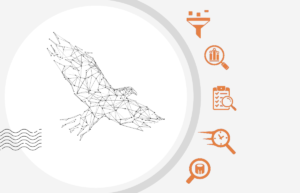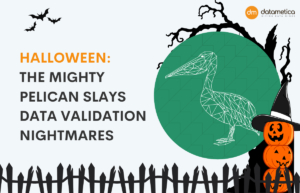
With the merry season comes the merrier times, that add the breeze of joy in the chilling air. The world has been rapidly moving up every possible ladder of digitalization to ease the functioning of businesses.
Data warehouse modernization is among the top priorities of businesses when it comes to business digitalization. According to Gartner’s research, 95% of data workloads will be hosted in the cloud by 2025. If you haven’t planned your cloud migration yet, today is the best time to get started.
Since the holiday season is considered the best season to get started with the upgrade of any business vertical, we can’t miss digitalization in the upgrade process. So, how can you get started?
Data Warehouse Migration Planning: Initial Steps for Your Cloud Ride
As you start your Christmas preparations by checking the required stuff you have in-house and then planning the celebration accordingly. In the same manner, for data warehouse migration, you need to start with an assessment of the data that you have stored for decades. Your data warehouse and data lakes might now have petabytes of data that needs to be migrated to the cloud. So before starting this process, it is important to understand the types of data that are stored in your data warehouse or lakes and then plan the cloud migration accordingly.
Data Warehouse Assessment
A comprehensive assessment of your current data warehouse or data lake is essential to fully evaluating the architecture, data stores, schema, business logic, data flows, DBMS functionality utilized, warehouse operation, and dependencies. It is an important step in preparing the data warehouse migration. The more understanding we can get here, the better. A thorough understanding of the system’s operation facilitates communication and ensures all bases are covered.
The assessment’s objectives include ensuring that the migration team has a strong understanding of the present system as well as identifying its strengths and weaknesses. In terms of lift and shift against something more comprehensive, the results of an evaluation of your present data warehouse could thus have an influence on your migration strategy.
Data Warehouse Modernization Planning
The next step is planning the cloud migration once you have resolved all the concerns raised during the assessment stage and have ultimately decided which cloud platform you will be using, as this will influence how easily the cloud migration will be carried out. This is one of the most crucial steps in the entire process. It’s important to be careful with the following during this process:
- Analyzing various apps, cloud environments, and the type of workload that has to be migrated.
- Evaluating the topology and architecture of the application.
- Examining various hybrid integration plans.
- Locating early adopters and consulting them for a seamless move to the cloud.
- As the initial step in any project using a cloud service, consider the Single Sign-On (SSO) procedures offered by the cloud provider.
- Determining whether any internal changes must be made in light of the new environment.
- Determining the deployment strategy for the changed code, data, and configurations in the new cloud environment.
The Need for Data Warehouse Migration Planning
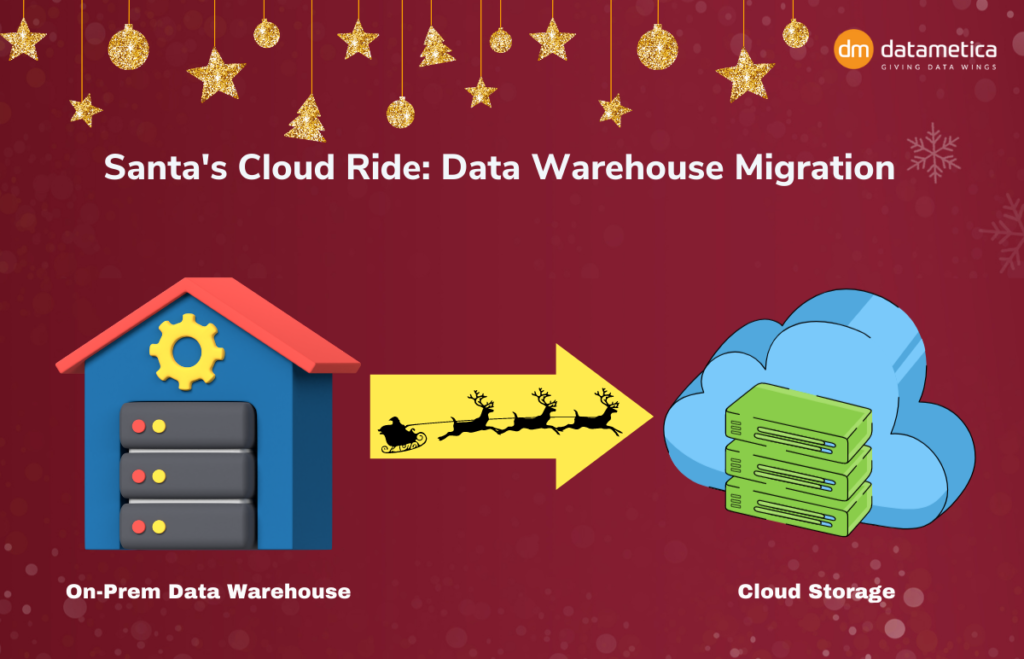
The process of data warehouse assessment, modern data catalog management, and data model management, are usually challenging and difficult, much like the data warehouses themselves. Time constraints make the task more difficult because there is typically not much time available for planning and assessment.
While moving to the cloud has many advantages, such as better flexibility, lower costs, and greater control, doing so might also cause some performance issues in the beginning.
These challenges are mostly brought on by infrastructure changes brought about by cloud migration. A cloud migration assessment aids in reducing risk during migration and prevents performance issues and business impacts. It aids migration planners in improving judgments and upholding service level agreements. App discovery, risk assessment, pre-migration prediction analysis, and dependency mapping are used to accomplish this based on current data usage.
Understanding the Legacy Data Source
It’s crucial to have a complete understanding of the present situation before starting the data warehouse migration project. Detailing your existing architecture, data stores, schema, business logic, data flows, warehouse operations, dependencies, and DBMS functionality not only provides your team with a strong foundation for determining what should come next, but it also accentuates the benefits and drawbacks of your current set-up.
A broad understanding of where the present system is succeeding and failing is essential for shaping the strategy to achieve that because the entire objective of migrating the data warehouse is to enhance something or everything!
Define the Scope and Mapping Specifications
The scope of your data warehouse migration should include not just what but also how much and when will be migrated. Are you migrating incrementally or all at once? Some companies choose to start by focusing on the most crucial matters, such as moving each data mart independently, before turning their attention to the data warehouse itself.
The mapping specifications are also essential for ensuring that your source data is functional with the target system. Mapping specifications are converted into migration code, which is subsequently checked for errors in test environments. Your ETL tool will be helpful in this situation. The data can be cleaned and restructured for the target system, and functions can be matched to your mapping requirements.
Plan for ETL and Version Upgrades
ETL and database version updates are essential components of any data warehouse migration checklist. Version updates for ETL will take place in the new IT environment. Upgrades to database versions will take place either in-place or in the new environment. The ETL provider should guarantee that you can recover the environment in the event that the ETL update process encounters complications.
The database vendor will offer that help if you’re updating an existing database version. The database version upgrade might be perfectly smooth, or complications and installation failures can mean you eventually end up installing a completely new database. Whatever the case, be ready for possible downtime.
Establish a Proof-of-Concept
Before you move forward with the data warehouse migration, reduce risks by allowing your team to test, identify and resolve concerns, and evaluate migration methodologies in a secure environment.
Finding out what works by experimenting can help you automate tasks more effectively and use best practices. You’ll enhance the performance of your new data warehouse and reduce expenses by simplifying everything in this proof-of-concept lab first. It’s a terrific technique to monitor your compliance with your established migration plan as well. To provide responsibility for achieving the objectives you included in your strategy, assign owners to each of your tests.
How can Datametica’s Eagle Ease Your Ride to the Cloud?
Just like the Christmas planner makes your holiday planning seamless, similarly, Datametica’s Eagle – data warehouse assessment and cloud mitigation planning technology eases your ride to any cloud platform.
As an automated cloud migration planner, Eagle evaluates the workload, logs, scheduler, scripts, ETL, ELT, and all dependencies in the on-premises database systems Netezza, Teradata, Oracle, and Hadoop to comprehend the workflows and data dependencies. Eagle also assists you in establishing a viable migration strategy and breaking the process down into phases.
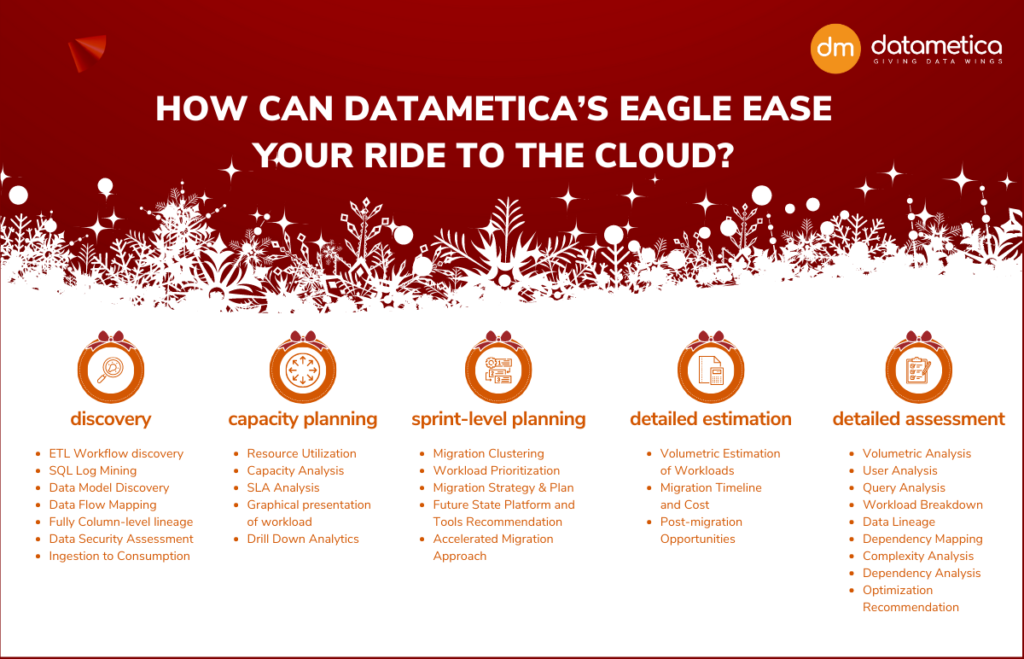
Eagle provides you with the ability to arrange workloads logically in order to move them in the correct order and prevent conflicts caused by dependencies. This is crucial for boosting migration and enhancing ROI.
Eagle: The Santa Your Data Warehouse Needs This Christmas Season
When we were kids, Santa was “Father Christmas,” whom we believed fulfilled all of our expectations and desires, but as business leaders, our expectations and desires have shifted. Data warehouse migration to the cloud is one of the leading desires business owners today have. And, Datametica’s Eagle is the one which can help you take the first step towards your wish of cloud migration. Eagle assesses the data warehouse, helps in data catalog discovery, and provides a concrete plan for cloud migration.
Eagle provides a complete overview of workloads, a robust migration plan, and a transparent migration path. Eagle provides an accurate estimate of the project timeframe and cost, thereby reducing risk in migration projects.

This Christmas, book a demo of our cloud migration planner and experience the Santa magic of Datametica’s Eagle yourself.
Stay tuned for the new version of Datametica’s Eagle, with additional capabilities and a more friendly dashboard.
Merry Christmas!!!
Happy New Year!!!
.
.
.
About Datametica
A Global Leader in Data Warehouse Modernization & Migration. We empower businesses by migrating their Data/Workload/ETL/Analytics to the Cloud by leveraging Automation.

